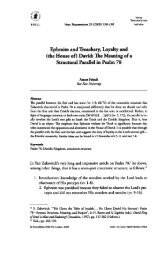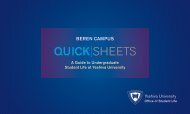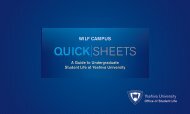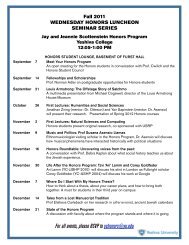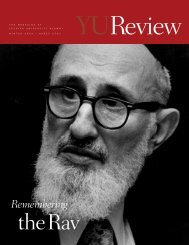36<strong>Richard</strong> C. <strong>Steiner</strong>divorce,” attested in two unpublished Aramaic magic bowls. 119 It canalso be compared to the form ר “and he caused to rain” (Exod9:23) found in a vocalized Genizah fragment of the PalestinianTargum. 120 In these forms, a short ḥireq or tsere appears to have beenpreserved or restored (by analogy) before resh by native speakers. Onthe other hand, it must be noted that the form נדירנא itself is notattested in Jewish Babylonian Aramaic; the only form attested in theTalmud is נדרנא “I do/shall vow” (Ned. 9a). 121 The yod that representsshort ḥireq 122 in כתיבנא is not found in ,נדרנא suggesting (although notproving conclusively) that the short ḥireq of the latter has beenlowered to pataḥ by the following resh. In short, the form נדירנא thatappears in 16th-century printed versions of <strong>Kol</strong> <strong>Nidre</strong> was probablycreated on the analogy of regular forms such as א rather thanhanded down by tradition.The rise of this non-standard form should not surprise us, since notreatises on Aramaic grammar were available to Jews at the time (andbecause similar forms are attested as passive participles). 123 Eventoday, when such treatises are available, the rule is unknown to manySemitists. Thus, a standard handbook of Semitic linguistics has thefollowing to say about the vocalization of the participle in one of the119כתיבנקערות ההשבעה הבבליות לחקרוְ אַמְ טֵI am indebted to an anonymous JSIJ reviewer for this information. Contrastlatter, “I shall divorce” in Qid. 64b. For the פטרנא at n. 55 above and פאטרaccording to the Talmud Text Databank (JTSA), פטרנ ' /פטרנא is the spelling inall witnesses: Oxford Opp. 248 (367), Munich 95, Vatican 111, JTS Rab. 2394,Spanish Print (ca. 1480), and Venice Print (1520), not to mention the Vilnaedition. Shamma Friedman informs me that פטרנא is the standard spelling in themagic bowls as well, occurring five times in the synoptic chart of five magicתרומתן של Bamberger, bowls published by Avigail30. 2012), Jerusalem, (Hebrew <strong>University</strong> master’s thesis; התלמוד ותקופתוThree of Bamberger’s five attestations appear in the synoptic chart of fourmagic bowls published by Dan Levene, A Corpus of Magic Bowls: IncantationTexts in Jewish Aramaic from Late Antiquity (London: Kegan Paul, 2003), 37.120Steven E. Fassberg, A Grammar of the Palestinian Targum Fragments fromthe Cairo Genizah (Atlanta: Scholars Press, 1990), 1990. This form contrastswith many forms that have pataḥ before resh, such as דַּ בַּ ר and שַׁ קַ ר .ומְ For other,more ancient examples of short e/i before final resh, etc. in Aramaic, see Beyer,Die aramäischen Texte, 1:108. According to Beyer, his examples are notexceptions; they simply predate the vowel shift that created the rule.121According to the Talmud Text Databank (JTSA), this is the spelling in theVenice edition of 1522 and the only extant manuscript (Vatican 487.1), not tomention the Vilna edition.122So in Jewish Babylonian Aramaic, not tsere.123See at n. 118 above.http://www.biu.ac.il/JS/JSIJ/12-2013/<strong>Steiner</strong>.pdf
<strong>Kol</strong> <strong>Nidre</strong>: Past, Present and Future37Late Aramaic dialects: “Syriac has qāber....” 124 In his review of thebook, E. Y. Kutscher points out the error: “This is a faulty form. As iswell known, Syriac (and other Aramaic dialects) turn an e before rinto an a. Therefore, the root ‘qbr’ for the paradigms turns out to beill-chosen.” 125The reading נדירנא is probably not original in Sefer Abudarham, butit is original in Bet Yosef, as is clear from the discussion there. R.Joseph Caro may have taken that reading from the printed edition ofSefer Abudarham and/or the printed edition of Toledot Adam we-Ḥawwah, both of which were published decades before thecompletion of Bet Yosef (1542). 126 The reading נדירנא is probably bestviewed as a hypercorrection—an overreaction to the nonsensical pasttensereading, הנהיג לומר דנדרנא ודאישתבענא ,וגם that was current atthe time. R. Abraham Abele Gombiner attributes the form נדירנא to R.Jeroham b. Meshullam (Toledot Adam we-Ḥawwah), rejecting it infavor of the form נדרנא used earlier by R. Meir ha-Kohen (HaggahotMaimuniyyot). 127In the passage quoted above, R. Joseph Caro also introduces a newdistinction into the discussion: די vs. - .ד As noted by a few authorities,this distinction is totally irrelevant, 128 a blatant red herring:R. Abraham b. Mordecai ha-Levi:ופי' דשתי תיבות מורה על העבר (צ"ל העתיד?) וכשהם תיבה א'מורה על העתיד (צ"ל העבר?) ואין דברים אלו נכונים וטעות גמורה124Sabatino Moscati, et al., An Introduction to the Comparative Grammar ofthe Semitic Languages (Wiesbaden: Harrassowitz, 1964), 146.125E. Y. Kutscher, review of Sabatino Moscati, et al., An Introduction to theComparative Grammar of the Semitic Languages in Asian and African Studies2 (1966), 200 = E. Y. Kutscher, Hebrew and Aramaic Studies (ed. Zeev Ben-Ḥayyim et al.; Jerusalem: Magnes, 1977), 182.126Both of those works are cited in Bet Yosef, but I am unable to say whetherthey were cited from the printed editions or from manuscripts.127ספר מגני ארץ והוא חיבור נחמד על in ,מגן אברהם Gombiner, .R Abraham Abeleהש"§619. 306a (Dyrenfurth: Shabbetai Meshorer Bass, 1692), ע הטור אורח חייםFor the forms in Toledot Adam we-Ḥawwah and Haggahot Maimuniyyot, see atnn. 78 and 115 above.128The form - דְּ is a proclitic form of דִּ י that developed in ancient colloquialAramaic; see <strong>Richard</strong> C. <strong>Steiner</strong>, “Papyrus Amherst 63: A New Source for theLanguage, Literature, Religion, and History of the Arameans,” StudiaAramaica: New Sources and New Approaches (ed. M. J. Geller, J. C.Greenfield, and M. P. Weitzman; Oxford, 1995), 201-202.http://www.biu.ac.il/JS/JSIJ/12-2013/<strong>Steiner</strong>.pdf
- Page 1: JSIJ 12 (2013) 1-45KOL NIDRE: PAST,
- Page 4 and 5: 4Richard C. Steinerנוהגים ה
- Page 6 and 7: 6Richard C. SteinerThe recitation o
- Page 8 and 9: 8Richard C. SteinerMy lord father c
- Page 10 and 11: 10Richard C. SteinerIn the name of
- Page 13: Kol Nidre: Past, Present and Future
- Page 16 and 17: 16Richard C. Steineruntil I come ba
- Page 19 and 20: צ(Kol Nidre: Past, Present and
- Page 21 and 22: Kol Nidre: Past, Present and Future
- Page 23 and 24: Kol Nidre: Past, Present and Future
- Page 25 and 26: Kol Nidre: Past, Present and Future
- Page 27 and 28: צ(Kol Nidre: Past, Present and
- Page 29 and 30: צ(Kol Nidre: Past, Present and
- Page 31 and 32: Kol Nidre: Past, Present and Future
- Page 33 and 34: Kol Nidre: Past, Present and Future
- Page 35: Kol Nidre: Past, Present and Future
- Page 39 and 40: Kol Nidre: Past, Present and Future
- Page 41 and 42: Kol Nidre: Past, Present and Future
- Page 43 and 44: Kol Nidre: Past, Present and Future
- Page 45 and 46: Kol Nidre: Past, Present and Future



